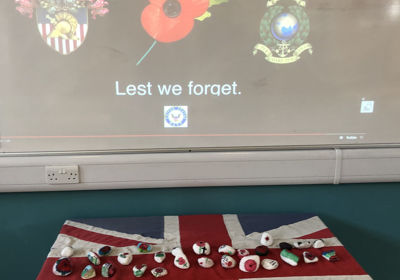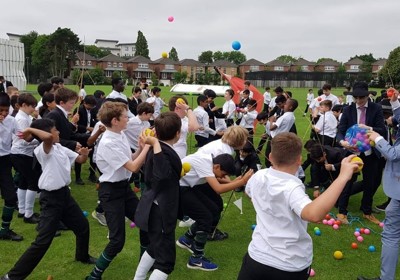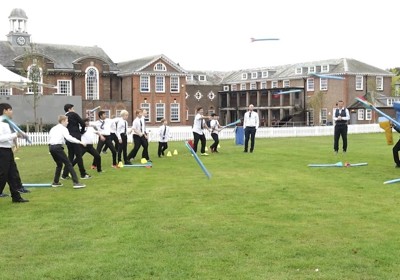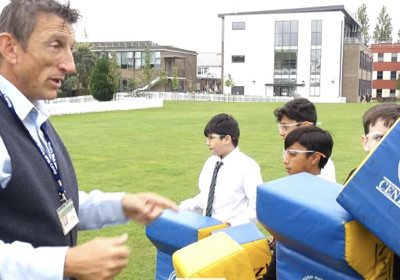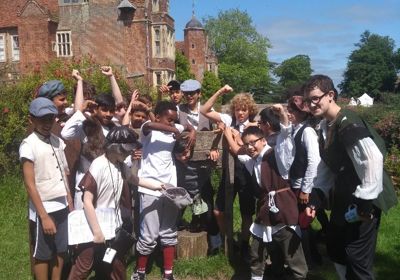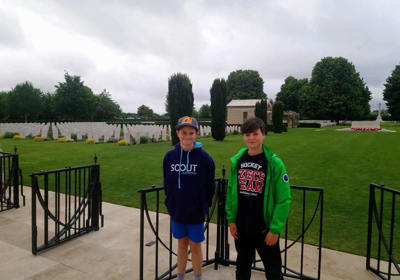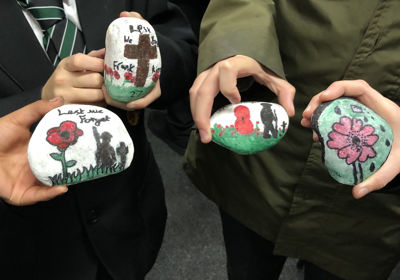History
Mr McDermott heads this large department with a wide range of specific historical interests and life experiences. The department organises the School’s annual remembrance day service each November; and is one of a number of departments which provides regular overseas and extra-curricular study visits.
The department is principally housed in four classrooms, all with their own audio-visual equipment, and also has a sixth form classroom for A-level Government and Politics teaching.
The staff and the environment have combined over the years to make both History and Politics popular examination options, with typically almost one hundred students studying History and more than sixty studying Politics at combined Lower and Upper Sixth levels. Usually, 120 students opt for History at GCSE level, making it one of the most popular options.
Key stage 3
History is a challenging and popular subject at Watford Grammar School for Boys. The key stage 3 History curriculum is designed to encourage the boys to think about the world they live in and answer big questions relating to society, religion, politics and ethics.
The skills that the boys develop during KS3 History – for example, source analysis, empathy, constructing arguments and effective writing – are designed to prepare the boys for onward study at KS4 across humanities subjects and the wider curriculum. Students at KS3 are encouraged to develop an interest in and love of reading. The school library is well resourced and used extensively over the KS3 History syllabus. All boys study History in their form groups during KS3.
YEAR 7 HISTORY – CONTRASTS AND CONNECTIONS
Term 1 – The boys begin Y7 by looking at England under the Normans. This includes why Britain was attractive to foreign rulers and migrants, the crisis of 1066 and the consequences of William of Normandy’s victory.
Term 2 – After looking at the Norman consolidation of power, the boys study the shape and challenges of life in Medieval Britain. This includes comparisons between rich and poor, religious life and the impact of the Black Death up to and including the Peasants' Revolt.
Term 3 – During Term 3 the boys undertake a comparative study of the Tudors and life in the English Civil War. This course is designed to encourage an appreciation of the impact of the religious changes in Britain. The boys have a fantastic opportunity to experience life as part of foot soldiers in the Sealed Knot recreation of the English Civil War. This morning involves musket practise, drilling, swordsmanship and a whole series of interactive talks with leading reenactors of Lorde Foote’s Regiment.
YEAR 8 HISTORY – SOCIETIES IN CHANGE
In year 8 the boys explore the great social and political changes of the Industrial Revolution and Victorian Britain (Jack The Ripper). Comparisons with modern events are a strong feature of the course and are used to encourage the boys’ interest in and understanding of our modern world.
Term 1 – The Y8 course begins with an overview of the Industrial Revolution and its impact on the way that we live today. This includes why Britain was the epicentre of industrial advancement and how this drove social, technological and political change. A core feature of this study is the development of the British Empire and the role that the Transatlantic Slave Trade played in this process. The boys also complete an independent research project on an aspect of Victorian life of their choosing.
Term 1.5 – Students make an in-depth investigation of Victorian Britain with a core focus on all the mystery and evidence surrounding Jack The Ripper, crime and punishment and the advance of policing in London at this time
Term 2 – During Spring term the boys focus on the First World War. This period is of great significance to Watford Grammar School for Boys, given the large number of former WBGS boys and staff who were involved in the conflict. This course includes the causes of the war, impacts of trench warfare and how life in Britain – the “Home Front” – was mobilised to support the war. The History Department has extensive resources on this period and is responsive to where the boys want to focus their learning. In the past this has included an appreciation of WW1 poetry, significant battles and the principal politicians and generals involved in the conflict.
Term 3 – The KS3 History curriculum ends in term 3 with a study on Europe between the wars and, specifically, the events and impact of WW2. Topics such as Dunkirk, the Battle of Britain and the Home Front are covered in detail. At Watford Grammar School for Boys we teach the Holocaust as part of students’ Year 8 historical journey after studying WWII. By law children are to be taught about the Holocaust as part of the Key Stage 3 History curriculum; in fact, the Holocaust is the only historical event whose study is compulsory on the National Curriculum
To further extra-curricular reading, students complete a book review on a historical novel from one of the periods studied in Y8. Boys also complete a research project on how London changed during the tumultuous years of the Restoration, Great Plague and Fire of London.
Key Stage 4
YEAR 9 HISTORY – PEACE & WAR
The year 9 History course is shorter than years 7 and 8 because students begin their GCSE courses after the year 9 autumn half-term. The year 9 course provides a platform for understanding and explaining the world in which we live.
Russian Revolution of 1917 - its causes and impacts
British Depth Study will provide essential practise for their GCSE - role of the suffrage movement in gaining women the right to vote.
Cold War in the wider world: Korean War and Vietnam
Term 2
The topics we study for GCSE History are particularly interesting and relevant to an understanding of modern world issues. Boys follow the Edexcel Modern World History GCSE and study the following topics:
Unit 1: Germany: Democracy to Dictatorship 1918-1939 Edexcel Specification
This unit focuses on the development of Germany during a turbulent half century of change. It was a period of democracy and dictatorship – the development and collapse of democracy and the rise and fall of Nazism. Students will study the political, economic, social and cultural aspects of these two developments and the role ideas played in influencing change. They will also look at the role of key individuals and groups in shaping change and the impact the developments had on them.
Part one - Germany and the growth of democracy:
Impact of the First World War: war weariness, economic problems; defeat; the end of the monarchy; post-war problems including reparations, the occupation of the Ruhr and hyperinflation.
Weimar democracy: political change and unrest, 1919–1923, including Spartacists, Kapp Putsch and the Munich Putsch; the extent of recovery during the Stresemann era (1924–1929): economic developments including the new currency, Dawes Plan and the Young Plan; the impact of international agreements on recovery; Weimar culture.
Part two - Germany and the Depression:
The impact of the Depression: growth in support for the Nazis and other extremist parties (1928–1932), including the role of the SA; Hitler’s appeal. • The failure of Weimar democracy: election results; the role of Papen and Hindenburg and Hitler’s appointment as Chancellor.
The establishment of Hitler’s dictatorship: the Reichstag Fire; the Enabling Act; elimination of political opposition; trade unions; Rohm and the Night of the Long Knives; Hitler becomes Führer.
Part three - The experiences of Germans under the Nazis
Economic changes: benefits and drawbacks; employment; public works programmes; rearmament; self-sufficiency; the impact of war on the economy and the German people, including bombing, rationing, labour shortages, refugees.
Social policy and practice: reasons for policies, practices and their impact on women and young people.
YEAR 10
Unit 2: Superpower relations and the Cold War, 1941–91
This wider world depth study enables students to understand the complex and diverse interests of different states and individuals and the ideologies they represented. It considers the role of nationalist movements in causing and sustaining conflict. It focuses on the causes and events of the Cold War in Europe and Asia and seeks to show how and why conflict occurred and why it proved difficult to resolve the tensions which arose. This study also considers the role of key individuals and groups in shaping change, as well as how they were affected by and influenced international relations.
Part One - The Grand Alliance:
The outcomes of the Tehran, Yalta and Potsdam conferences.
The ideological differences between the superpowers and the attitudes of Stalin, Truman and Churchill.
The impact on US-Soviet relations of the development of the atomic bomb, the Long and Novikov telegrams and the creation of Soviet satellite states in Eastern Europe. The development of the Cold War
The impact on US-Soviet relations of the Truman Doctrine and the Marshall Plan, 1947.
The significance of Cominform (1947), Comecon (1949) and the formation of NATO (1949).
Berlin: its division into zones. The Berlin Crisis (blockade and airlift) and its impact. The formation of the Federal Republic of Germany and German Democratic Republic.
The Cold War intensifies
The significance of the arms race and the formation of the Warsaw Pact.
Events in 1956 leading to the Hungarian Uprising, and Khrushchev’s response.
The international reaction to the Soviet invasion of Hungary.
Part Two: Cold War crises, 1958–70 1 Increased tension between East and West
The refugee problem in Berlin, Khrushchev’s Berlin ultimatum (1958), and the summit meetings of 1959–61.
Soviet relations with Cuba, the Cuban Revolution and the refusal of the USA to recognise Castro’s government. The significance of the Bay of Pigs incident.
Opposition in Czechoslovakia to Soviet control: the Prague Spring. 2 Cold War crises ● The construction of the Berlin Wall, 1961.
The events of the Cuban Missile Crisis.
The Brezhnev Doctrine and the re-establishment of Soviet control in Czechoslovakia.
Reaction to crisis
Impact of the construction of the Berlin Wall on US-Soviet relations. Kennedy’s visit to Berlin in 1963.
The consequences of the Cuban Missile Crisis: the ‘hotline’, the Limited Test Ban Treaty 1963; the Outer Space Treaty 1967; and the Nuclear Non-Proliferation Treaty 1968.
International reaction to Soviet measures in Czechoslovakia.
Part Three: The end of the Cold War, 1970–91 1 Attempts to reduce tension between East and West
Détente in the 1970s, SALT 1, Helsinki, and SALT 2.
The significance of Reagan and Gorbachev’s changing attitudes.
Gorbachev’s ‘new thinking’ and the Intermediate-Range Nuclear Force (INF) Treaty 1987. 2 Flashpoints
The significance of the Soviet invasion of Afghanistan, the Carter Doctrine and the Olympic boycotts.
Reagan and the ‘Second Cold War’, the Strategic Defence Initiative. 3 The collapse of Soviet control of Eastern Europe
The impact of Gorbachev’s ‘new thinking’ on Eastern Europe: the loosening Soviet grip on Eastern Europe.
The significance of the fall of the Berlin Wall.
The collapse of the Soviet Union and its significance in bringing about the end of the Warsaw Pact.
Unit 3: Warfare and British society, c1250–present and London and the Second World War, 1939–45
This thematic study will enable students to gain an understanding of the development of warfare in Britain over a long period of time, with a focus on London in WWII. It considers the causes, scale, nature and consequences of warfare to that relationship. By charting the journey from medieval Britain to the present, it reveals how, in different periods, the state responds to challenges of war fare and the changing nature of fighting and battles. Students will study how factors worked together to bring about particular developments at a particular time and their impact upon society. Students will develop an understanding of the varying rate of change.
In studying the content defined below in strands 1 and 2, students should understand how key features in the development of warfare on land were linked with the key features of society in Britain in the periods studied.
They should develop an understanding of the nature and process of change. This will involve understanding patterns of change, trends and turning points, and the influence of factors inhibiting or encouraging change within periods and across the theme. The key factors are: governments and individuals; science, technology and communications; and attitudes in society.
They should also understand how factors worked together to bring about particular developments at particular times.
The selected case studies in strand 3 of each period exemplify, in context, elements defined in strands 1 and 2. They provide opportunities to explore the operation of the key factors and to make detailed comparisons over time. c1250–c1500: Medieval warfare and English society 1 The nature of warfare.
The composition of the army, including the roles of the infantry, archer and the mounted knight. The link between social structure and army command.
The impact on warfare (strategy, tactics and combat) of new weapons and formations, including the longbow and schiltrons. The importance of gunpowder and the development of cannon. The decline of the mounted knight. 2 The experience of war.
The recruitment and training of combatants in the medieval feudal army.
The impact of war on civilians, including the impact of feudal duties and army plunder on civilian lives.
Case studies
The Battle of Falkirk, 1298: reasons for its outcome; the roles of William Wallace and Edward I.
The Battle of Agincourt, 1415: reasons for its outcome; the role of Henry V.
c1500–c1700: Warfare and English society in the early modern period 1 The nature of warfare
Continuity and change in the composition of the army in the sixteenth and seventeenth centuries, including the role of the musketeer, pikemen, dragoons and the cavalry. The development of a standing army.
The impact on warfare of developments in weaponry, including new muskets and pistols. 2 The experience of war
The recruitment and training of combatants, including the New Model Army.
The impact of war on civilians, including recruitment and requisitioning.
Case study
The Battle of Naseby, 1645: reasons for its outcome; the role of Oliver Cromwell. c1700–c1900:
Warfare and British society in the eighteenth and nineteenth centuries 1 The nature of warfare
Continuity and change in the composition of the army, including the decline of the cavalry.
Impact on warfare of changes in weaponry, including the use of rifles and bullets, and the development of field guns and heavy artillery. The impact on warfare of industrialisation, including steampowered transport and the mass production of weapons. 2 The experience of war
The recruitment and training of combatants, including Cardwell’s army reforms and professionalisation.
The impact of war on civilians, including recruitment and requisitioning. The impact on popular attitudes of the growth of newspaper reporting and photography in the nineteenth century, exemplified in the Crimean and Boer Wars.
Case studies
The Battle of Waterloo, 1815: reasons for its outcome; the role of the Duke of Wellington.
The Battle of Balaclava, 1854: reasons for its outcome; the role of Lord Raglan.
c1900–present: Warfare and British society in the modern era 1 The nature of warfare
Continuity and change in the composition of the army, including the growth of a logistics corps and specialised bomb disposal units.
The impact on warfare of developments in weaponry, transport and surveillance, including machine guns, tanks, chemical and nuclear weapons, the use of radar and aircraft. The impact of computerised high-tech warfare. The increasing use of motor and air transport and aerial support. Dealing with guerrilla warfare in the twenty-first century. 2 The experience of war
The recruitment and training of combatants, including the introduction of conscription, national service, the recruitment of women and the development of a professional army.
The impact of war on civilians, including recruitment and the organisation of a Home Front during the First and Second World Wars and fear of nuclear war post-1945. Attitudes to conscientious objectors. The influence of war reporting in the period on attitudes, including increased concern for casualties. Government use of censorship and propaganda in wartime.
Case studies
The Western Front during the First World War and the Battle of the Somme, 1916: the nature of trench warfare and war of attrition; reasons for the outcome of the Somme; role of General Haig.
The Iraq War 2003: reasons for its outcome; use of high-tech weaponry and surveillance techniques.
The Historic Environment: London and the Second World War, 1939–45
The context of London in the Second World War, including its role in national government, significance as a target, importance as a port and industrial centre and its accessibility for German bombers. Preparations for war in London, 1939 and ongoing measures to safeguard the population: implementation of plans for evacuation, provision of Anderson shelters and gas masks.
The nature of attacks on London. Attacks on the docks and industries of the East End, including Black Saturday (7 September 1940), and the V2 attack on Deptford, 1944. Types of bomb used in 1940–41 and 1944–45, the scale of attack and extent of devastation, including problems dealing with incendiaries and V1 and V2 rockets.
The impact of the Blitz on civilian life in London: air-raid precautions, including the use of underground stations and ‘Mickey’s shelter’; the impact of the South Hallsville School, (1940) and Bethnal Green (1943) disasters. The continuance of leisure activities in London, including dancehalls and theatre. The extent of disruption to daily life and work, and government concerns about morale.
London’s response to the war. The continued presence of the royal family and government ministers; the Cabinet War Rooms. Measures taken to safeguard art and important buildings. The use of public spaces, including Victoria Park and the Tower of London moat, as part of the ‘Dig for Victory’ campaign.
The historical context of the Second World War: the nature and purpose of the Blitz. Government use of propaganda and censorship to influence attitudes about the Blitz. 2 Knowledge, selection and use of sources for historical enquiries
Knowledge of local sources relevant to the period and issue, e.g. personal accounts and photographs, local newspapers, local council records.
Knowledge of national sources relevant to the period and issue, e.g. government records, newspapers, Mass Observation reports, newsreels, memoirs.
Recognition of the strengths and weaknesses of different types of source for specific enquiries.
Framing of questions relevant to the pursuit of a specific enquiry.
Selection of appropriate sources for specific investigations.
Unit 4: Early Elizabethan England, 1558–88
Students will study in depth the last 35 years of Elizabeth I's reign. The study will focus on major events of Elizabeth I’s reign considered from economic, religious, political, social and cultural standpoints, and arising contemporary and historical controversies.
Key topic 1: Queen, government and religion, 1558–69 1 The situation on Elizabeth’s accession
Elizabethan England in 1558: society and government.
The Virgin Queen: the problem of her legitimacy, gender, marriage. Her character and strengths.
Challenges at home and from abroad: the French threat, financial weaknesses.
The ‘settlement’ of religion
Religious divisions in England in 1558.
Elizabeth’s religious settlement (1559): its features and impact.
The Church of England: its role in society. 3 Challenge to the religious settlement
The nature and extent of the Puritan challenge.
The nature and extent of the Catholic challenge, including the role of the nobility, Papacy and foreign powers. 4 The problem of Mary, Queen of Scots
Mary, Queen of Scots: her claim to the English throne, her arrival in England in 1568.
Relations between Elizabeth and Mary, 1568–69.
Key topic 2: Challenges to Elizabeth at home and abroad, 1569–88 Plots and revolts at home
The reasons for, and significance of, the Revolt of the Northern Earls, 1569–70.
The features and significance of the Ridolfi, Throckmorton and Babington plots. Walsingham and the use of spies.
The reasons for, and significance of, Mary Queen of Scots’ execution in 1587.
Relations with Spain
Political and religious rivalry.
Commercial rivalry. The New World, privateering and the significance of the activities of Drake. 3 Outbreak of war with Spain, 1585–88
English direct involvement in the Netherlands, 1585–88. The role of Robert Dudley.
Drake and the raid on Cadiz: ‘Singeing the King of Spain’s beard’. 4 The Armada
Spanish invasion plans. Reasons why Philip used the Spanish Armada.
The reasons for, and consequences of, the English victory
Key stage 5
The new A-level has been constructed to afford a much broader and deeper understanding of a range of political, social and economic histories of different countries in the 19th and 20th centuries. The skills used at GCSE are developed in A-level and prepare students for a variety of courses at university. Studying History allows you to interpret, investigate and debate before coming to reasoned conclusions, which is a highly sought-after skill-set for any career path you choose.
Route E: Communism in the 20th Century
Paper 1: Russia 1917-91 from Lenin to Yeltzin
This option comprises a study in breadth, in which students will learn about the key political, social and economic features of communist rule in Russia during the twentieth century, an era that saw the USSR’s authority and influence rise to the status of a superpower, only to diminish and decline later in the century:
Establishing Communist Party control under Lenin, 1917–24:
-
Stalin in power, 1928–53: The secret police, purges and WWII
-
Reform, stability and stagnation, 1953–85
-
Industry and agriculture in the Stalin era: the Five-Year Plans
-
State control of mass media, propaganda and religion
-
The personality cults of Lenin, Stalin, Khrushchev and Brezhnev
30% A-level (Essays and historical interpretations)
Paper 2: Mao’s China 1949-76
Investigates in depth the impact of Mao’s reorganisation of China with emphasis on Communist ideology and the part it played in political, economic, social and foreign policy.
-
China before the Revolution in 1949
-
Takeover and consolidation of power by Mao
-
Rebuilding of China: Agriculture, Industry, Five Year Plans
-
Great Leap Forward: Causes, Effects and Impact
-
Terror and Control
-
Cultural Revolution
-
Foreign Policy: Cold War conflicts – Korea, Vietnam and ping pong diplomacy [1969-the-chinese-peoples-liberation]
A-level 20% (Interpretations and source essays)
Paper 3: Britain: Losing and Gaining an Empire 1763 -1914
This option offers boys the opportunity to study Britain's influence on the development of the world during an exciting period of History. It offers a broad overview from the mid-18th century to the outbreak of the First World War. Key events that have shaped our modern world politics will be studied such as the American War of Independence, complemented by individuals such as Gordon of Khartoum. The focus moves away from Europe to considering countries not touched at GCSE such as Australia, India and Africa. This is an exciting opportunity for boys to discover how Britain came to rule one quarter of the world's land surface changing politics, society and the global economy for ever.
-
The Origins of British Power
-
The Indian Mutiny and Its Impact
-
The British Raj 1858-1914
-
The Nature of Colonial Society
-
The Role of the Indian Army
-
The Great Game: The Northwest Frontier and Rivalry with Russia
30% Source analysis and essays
Paper 4: Coursework: India and the British Empire 1757-1947
This is an essay assignment that considers a range of interpretations over distinct issues in Indian history within the British Empire up to independence in 1947. Students will devise a question and tackle it using a range of accessible source and reference material before reaching an evaluated conclusion. This follows on from Paper 3 learning and can include:
-
The Rise of Indian Nationalism
-
The Amritsar Massacre of 1919 and its Impact
-
Gandhi’s Campaigns for Civil Rights and Independence and their Impacts
-
British Politics and India 1919-39
-
India and the Second World War
-
The Fall of Singapore and Its Impact on the Image of Imperial Superiority (Pax Britannica?)
-
The End of the Empire
-
Economic Pressures on Post-War Britain and their Impact on Imperial Policy
-
Attlee’s Labour government and Britain’s decision to withdraw
-
The Role of Key Personalities in the rise of Muslim and Indian Nationalism
-
The Outbreak and Impact of Communal Violence 1947
20% of A-level Historio-graphical analysis and evaluation of interpretations
Exams & Assessment
GCSE
Edexcel Modern World History
A Level
Edexcel New History
Enrichment & Extra-curricular
TRIPS & VISITS
KS3 History trip to Normandy and the D-day landing beaches.
Y7 boys who participate in the lunchtime History Boys club also have the opportunity to go on other visits to Kentwell which is an immersive and interactive Tudor experience.
In the past we have also included trips to the Globe and Greenwich.
The school operates a bi-annual trip to Berlin for boys in year 9 and year 10. This is designed to consolidate previous learning on this pivotal city in Cold War History and further study of Weimar and Nazi Germany at key stage 4.
In addition to the bi-annual Berlin trip, which many boys choose to go on in year 9, the boys in Year 10 visit the Imperial War Museum during the year. The Museum offers an excellent range of interactive exhibits and consolidates the boys’ learning and appreciation of the sacrifices made by those who lived during the wars.
CLUBS & SOCIETIES
History Boys Academic Society - Lunchtime club on Wednesday
Politics Society on Lunchtime - Thursday
Model UN
Debating Society
Resources & Reading List
Students read about independent study of History at Key Stage 4 here: (Please note, students will be required to be logged in with their school Google account to read this)

